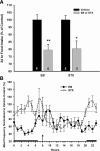Contribution of a membrane estrogen receptor to the estrogenic regulation of body temperature and energy homeostasis
- PMID: 20685867
- PMCID: PMC2946146
- DOI: 10.1210/en.2010-0573
Contribution of a membrane estrogen receptor to the estrogenic regulation of body temperature and energy homeostasis
Abstract
The hypothalamus is a key region of the central nervous system involved in the control of homeostasis, including energy and core body temperature (Tc). 17β-Estradiol (E2) regulates Tc, in part, via actions in the basal hypothalamus and preoptic area. E2 primarily controls hypothalamic functions via the nuclear steroid receptors, estrogen receptor α/β. However, we have previously described an E2-responsive, Gq-coupled membrane receptor that reduces the postsynaptic inhibitory γ-aminobutyric acid-ergic tone and attenuates postovariectomy body weight gain in female guinea pigs through the administration of a selective Gq-mER ligand, STX. To determine the role of Gq-mER in regulating Tc, energy and bone homeostasis, ovariectomized female guinea pigs, implanted ip with temperature probes, were treated with STX or E2 for 7-8 wk. Tc was recorded for 4 wk, whereas food intake and body weight were monitored daily. Bone density and fat accumulation were determined postmortem. Both E2 and STX significantly reduced Tc in the females compared with controls. STX, similar to E2, reduced food intake and fat accumulation and increased tibial bone density. Therefore, a Gq-mER-coupled signaling pathway appears to be involved in maintaining homeostatic functions and may constitute a novel therapeutic target for treatment of hypoestrogenic symptoms.
Figures







Similar articles
-
Cross-talk between membrane-initiated and nuclear-initiated oestrogen signalling in the hypothalamus.J Neuroendocrinol. 2009 Mar;21(4):263-70. doi: 10.1111/j.1365-2826.2009.01846.x. J Neuroendocrinol. 2009. PMID: 19187465 Free PMC article. Review.
-
Genes associated with membrane-initiated signaling of estrogen and energy homeostasis.Endocrinology. 2008 Dec;149(12):6113-24. doi: 10.1210/en.2008-0769. Epub 2008 Aug 28. Endocrinology. 2008. PMID: 18755790 Free PMC article.
-
Rapid signaling of estrogen in hypothalamic neurons involves a novel G-protein-coupled estrogen receptor that activates protein kinase C.J Neurosci. 2003 Oct 22;23(29):9529-40. doi: 10.1523/JNEUROSCI.23-29-09529.2003. J Neurosci. 2003. PMID: 14573532 Free PMC article.
-
The membrane estrogen receptor ligand STX rapidly enhances GABAergic signaling in NPY/AgRP neurons: role in mediating the anorexigenic effects of 17β-estradiol.Am J Physiol Endocrinol Metab. 2013 Sep 1;305(5):E632-40. doi: 10.1152/ajpendo.00281.2013. Epub 2013 Jul 2. Am J Physiol Endocrinol Metab. 2013. PMID: 23820624 Free PMC article.
-
Gq-mER signaling has opposite effects on hypothalamic orexigenic and anorexigenic neurons.Steroids. 2014 Mar;81:31-5. doi: 10.1016/j.steroids.2013.11.007. Epub 2013 Nov 20. Steroids. 2014. PMID: 24269736 Free PMC article. Review.
Cited by
-
The role of estrogens in control of energy balance and glucose homeostasis.Endocr Rev. 2013 Jun;34(3):309-38. doi: 10.1210/er.2012-1055. Epub 2013 Mar 4. Endocr Rev. 2013. PMID: 23460719 Free PMC article. Review.
-
G protein-coupled estrogen receptor in energy homeostasis and obesity pathogenesis.Prog Mol Biol Transl Sci. 2013;114:193-250. doi: 10.1016/B978-0-12-386933-3.00006-6. Prog Mol Biol Transl Sci. 2013. PMID: 23317786 Free PMC article. Review.
-
The Effects of Estrogens on Neural Circuits That Control Temperature.Endocrinology. 2021 Aug 1;162(8):bqab087. doi: 10.1210/endocr/bqab087. Endocrinology. 2021. PMID: 33939822 Free PMC article. Review.
-
Membrane estrogen receptor regulation of hypothalamic function.Neuroendocrinology. 2012;96(2):103-10. doi: 10.1159/000338400. Epub 2012 Sep 14. Neuroendocrinology. 2012. PMID: 22538318 Free PMC article. Review.
-
Feeding neurons integrate metabolic and reproductive states in mice.iScience. 2023 Sep 14;26(10):107918. doi: 10.1016/j.isci.2023.107918. eCollection 2023 Oct 20. iScience. 2023. PMID: 37817932 Free PMC article.
References
-
- Koehl M, Battle SE, Turek FW 2003 Sleep in female mice: a strain comparison across the estrous cycle. Sleep 26:267–272 - PubMed
-
- Rashotte ME, Ackert AM, Overton JM 2002 Ingestive behavior and body temperature during the ovarian cycle in normotensive and hypertensive rats. Am J Physiol Regul Integr Comp Physiol 282:R216–R225 - PubMed
-
- Yochim JM, Spencer F 1976 Core temperature in the female rat: effect of ovariectomy and induction of pseudopregnancy. Am J Physiol 231:361–365 - PubMed
-
- Czaja JA, Butera PC 1986 Body temperature and temperature gradients: changes during the estrous cycle and in response to ovarian steroids. Physiol Behav 36:591–596 - PubMed
-
- Coyne MD, Kesick CM, Doherty TJ, Kolka MA, Stephenson LA 2000 Circadian rhythem changes in core temperature over the menstrual cycle: method for noninvasive monitoring. Am J Physiol Regul Intergr Comp Physiol 279:R1316–R1320 - PubMed
Publication types
MeSH terms
Substances
Grants and funding
LinkOut - more resources
Full Text Sources
Miscellaneous

